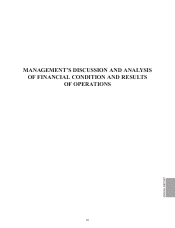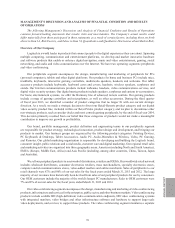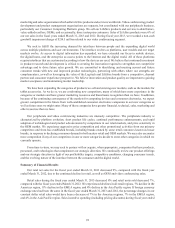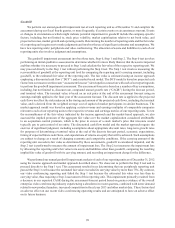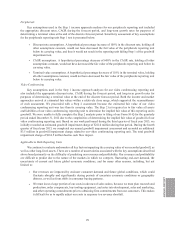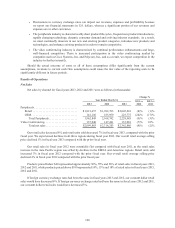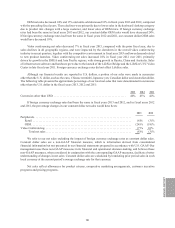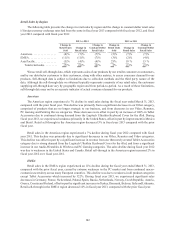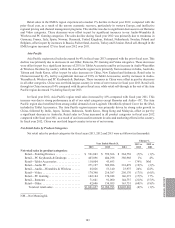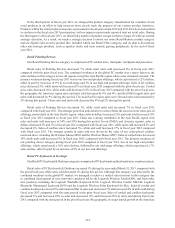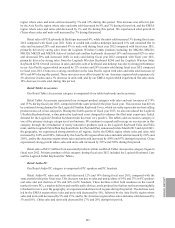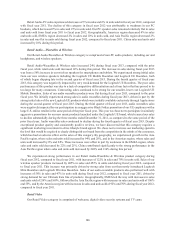Logitech 2013 Annual Report Download - page 98
Download and view the complete annual report
Please find page 98 of the 2013 Logitech annual report below. You can navigate through the pages in the report by either clicking on the pages listed below, or by using the keyword search tool below to find specific information within the annual report.Customer Incentive Programs. Customer incentive programs include performance-based incentives and
consumer rebates. We offer performance-based incentives to our distribution customers, retail customers and
indirect partners based on pre-determined performance criteria. Accruals for performance-based incentives are
recognized as a reduction of the sale price at the time of sale. Estimates of required accruals are determined based
on negotiated terms, consideration of historical experience, anticipated volume of future purchases, and inventory
levels in the channel. Consumer rebates are offered from time to time at the Company’s discretion for the primary
benefit of end-users. Estimated costs of consumer rebates and similar incentives are recorded at the time the
incentive is offered, based on the specific terms and conditions. Certain incentive programs, including consumer
rebates, require management to estimate the number of customers who will actually redeem the incentive based on
historical experience and the specific terms and conditions of particular programs.
Pricing Programs. We have agreements with certain of our customers that contain terms allowing price
protection credits to be issued in the event of a subsequent price reduction. At management’s discretion, we also
offer special pricing discounts to certain customers. Special pricing discounts are usually offered only for limited
time periods or for sales of selected products to specific indirect partners. Our decision to make price reductions is
influenced by product life cycle stage, market acceptance of products, the competitive environment, new product
introductions and other factors. Estimates of expected future pricing actions are recognized at the time of sale
based on analyses of historical pricing actions by customer and by product, inventories owned by and located at
distributors and retailers, current customer demand, current operating conditions, and other relevant customer and
product information, such as stage of product life-cycle.
We regularly evaluate the adequacy of our accruals for product returns, cooperative marketing arrangements,
customer incentive programs and pricing programs. Future market conditions and product transitions may require
us to take action to increase such programs. In addition, when the variables used to estimate these costs change,
or if actual costs differ significantly from the estimates, we would be required to record incremental increases
or reductions to revenue or increase operating expenses. If, at any future time, we become unable to reasonably
estimate these costs, recognition of revenue might be deferred until products are sold to end-users, which would
adversely impact revenue in the period of transition.
Inventory Valuation
We must order components for our products and build inventory in advance of customer orders. Further,
our industry is characterized by rapid technological change, short-term customer commitments and rapid changes
in demand.
We record inventories at the lower of cost or market value and record write-downs of inventories which
are obsolete or in excess of anticipated demand or market value. A review of inventory is performed each fiscal
quarter that considers factors including the marketability and product life cycle stage, product development plans,
component cost trends, demand forecasts and current sales levels. We identify inventory exposures by comparing
inventory on hand, in the channel and on order to historical and forecasted sales over forecasted sales periods.
Inventory on hand which is not expected to be sold or utilized based on review of forecasted sales and utilization is
considered excess, and we recognize the write-off in cost of sales at the time of such determination. The write-off
is determined by comparison of the current replacement cost with the estimated selling price less any costs of
completion and disposal (net realizable value) and the net realizable value less an allowance for normal profit. At
the time of loss recognition, a new, lower-cost basis for that inventory is established and subsequent changes in facts
and circumstances would not result in an increase in the cost basis. If there were an abrupt and substantial decline
in demand for Logitech’s products or an unanticipated change in technological or customer requirements, we may
be required to record additional write-downs which could adversely affect gross margins in the period when the
write-downs are recorded.
96





